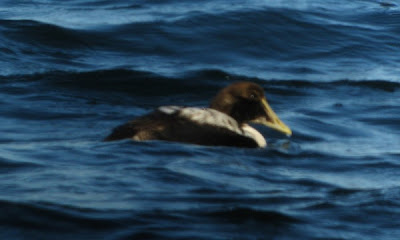In his post yesterday on Common Eiders, Corey quoted Pete Dunne's Essential Field Guide Companion on eider distribution: “Several decades ago, King Eider was the expected wintering eider south of New England. Sightings of Common Eider were considerably fewer. This has changed, and Common Eider now lives up to its name, outnumbering King Eider along the mid-Atlantic coast.” Curious about this, I decided to check some historical sources to see when things changed.
John Bull's Birds of the New York Area (1964) states that King Eider was historically seen more frequently than Common Eider off Montauk in Long Island. It attributes changes in winter distribution to population growth at the Common Eider's breeding grounds. For example, the breeding flock at Muscongus Bay in Maine grew from 800 in 1949 to 6,000 in 1959. Bull also mentions an impressive irruption of King Eiders in the winter of 1887, in which flocks of 20 and 30 were recorded.
For historical records in coastal New Jersey, one place to turn is Witmer Stone's Bird Studies at Old Cape May. This book was first published in 1937 based on observations from the preceding decades. What makes the book valuable is that Stone reports his own observations as well as those of other ornithologists and sometimes cites 18th and 19th century observers as well. Though dated, it provides an interesting window into past bird distribution in the state. Regarding eiders, Stone first notes that many observers (including hunters) were unfamiliar with either King or Common Eiders. (Stone refers to Common Eiders as American Eiders.) He then lists observations for Common Eiders in the Cape May area:
The only records that we have were made by the Audubon Association wardens stationed at the Point. A female or immature male was seen by William Rusling on the ocean off Cape May Point near the jetties in front of the Villa Maria. It remained there from October 10 to 14, 1935, and he watched it several times a day for four days having it in good view, once within twenty-five feet. When caught by the tide and carried out from shore it immediately swam back to the jetties. He identified it as an American Eider.Turning to King Eider, Stone notes that most of the specimens are young birds and that there had been no recent sightings in Cape May County, but that specimens had been shot in 1928 (in Great Bay) and 1900 (on the lower Delaware). He continues:
Three were seen off the end of the jetty at the entrance to the Harbor, on November 3, 1936, by James Tanner.
In the Barnegat Bay region several of these ducks have been seen. Charles Urner sends me the following list: One on November 3, 1930 (Harry Ridgway); a drake, January 11, 1931; one on December 27, 1931 (Lester Walsh and Charles Nichols); two on December 17, 1932 (Oscar Eyre); one drake, on December 26, 1932 (Urner and others); one young drake, February 18, 1934 (Urner).
Charles Urner sends me the following list of individuals observed in the Barnegat Bay region by him or his associates: One December 15, 1924, (Watson); one March 3, 1929 (Jacques); two November 9, 1930; one January 14, 1934; two February 4, 1934; four February 18, 1934. The 1934 birds were seen immediately following the extremely cold weather of that winter which was undoubtedly the cause of their southward wandering.The impression I get from Stone is that neither species was common but that both made regular appearances along New Jersey's southern coast, either singly or in groups. I do not know of a similar resource for more recent decades, though one could probably piece it together by going through back issues of New Jersey Birds and its predecessors. As an alternative, I turned to archived Christmas Bird Counts. Using historical CBC data presents problems since participation and coverage have changed over time and count circles have gone in and out of existence. However, using birds per party hour controls somewhat for effort and New Jersey has some long-running counts along the coast. Here is graph for New Jersey since the winter of 1940-41, roughly Stone's time to ours.
This leaves a somewhat muddled impression because it is dominated by a few tall spikes and lacks a clear trend, though sightings of Common Eiders have increased in frequency in the second half of the time period. Adding Delaware and Maryland shows a somewhat clearer trend.
This shows an increase in Common Eiders in the second half of the time period, while King Eider sightings have held more of less steady. These days Common Eiders are fairly easy to find along New Jersey's shore since large numbers winter at or migrate past Barnegat Inlet and Cape May Point, with smaller numbers wintering farther south. King Eiders are regular, at least in New Jersey, but are usually single birds and are much harder to find. So it seems, at least, that Common Eiders have become much more frequent and abundant in the Mid-Atlantic states since the early 20th century. What remains unclear to me is whether King Eider was really more common than Common Eider in this area, at least south of Long Island. So far, the sources I have checked seem to show relatively equal abundance for the two species in years past.






